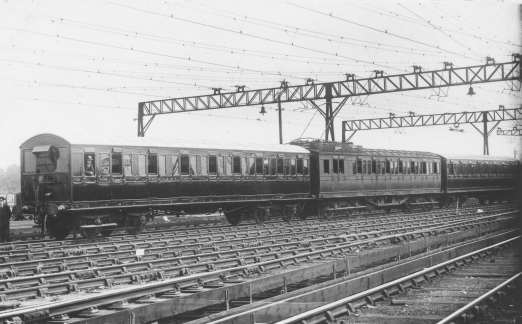
© A.J. Wills Postcard Collection, Southern Railway Photo Net
 |
CP stock at Selhurst depot © A.J. Wills Postcard Collection, Southern Railway Photo Net |
In 1905 one of the Southern Railway's constituent companies, the London, Brighton and South Coast Railway (LBSCR), embarked on a programme of electrification on the 6.6kV a.c. overhead system and built three fleets of electric rolling stock to operate the newly electrified lines. SL stock The South London Line between London Bridge and Victoria via Peckham Rye and Battersea Park was chosen as a pilot project, with the intention of extending electrification to other suburban lines and ultimately to the company's main lines as well. Eight 3-car units, configured Driving Motor Brake Third (DMBT), Trailer First (TF), DMBT, were built in 1908-09 by the Metropolitan Amalgamated Railway Carriage and Wagon Co. These cars had 9ft wide bodies instead of the LBSCR standard 8ft and, at 60ft, were also longer than standard. They had internal side-aisles linking the compartments, intended to encourage passengers to board promptly through the nearest door and seek empty seats after entering. The proportion of First Class accommodation in the SL units was soon found to be too great so in 1910-11 these sets were disbanded. The TFs were converted to locomotive hauled coaches and were later converted again by the Southern Railway into 2-car d.c. units (2 Wim.) for the Wimbledon-West Croydon line. Following this change of plan, the 'SL' DMBTs ran paired with driving trailer composites (DTC), probably initially and temporarily 'CP' stock cars. 14 DTCs were converted in 1910-12 from former locomotive-hauled stock. Trains ran as two- four- or six-cars according to demand and cars were no longer kept in semi-permanent units. CP stock At 60ft long and 9ft wide, the original 'SL' cars were too large to pass through Crystal Palace tunnel, so subsequent a.c. electric passenger cars were 54ft long and 8ft wide, closely resembling contemporary LBSCR locomotive-hauled stock and with passenger accommodation in conventional non-corridor compartments. The 'CP' stock of 1911-13, built for the extension of a.c. overhead electrification to Crystal Palace, consisted of 34 Driving Motor Brake Thirds (DMBT) and 68 Driving Trailer Composites (DTC), usually formed into three-car sets comprising DTC-DMBT-DTC. More driving trailers were built between 1914 and 1921 but, in the difficult wartime and postwar economic conditions, they were surplus to requirements and were reassigned to the pool of steam-hauled coaches. Some were later retrieved to be included in the 'CW' stock (below). CW stock The 'CW' stock was ordered by the LBSCR for the extension of a.c. overhead electrification to Coulsdon and Wallington. This project was completed in 1925 by which time the LBSCR had been amalgamated into the Southern Railway. Perhaps with later main-line electrification in mind, the LBSCR moved away from the concept of powered passenger coaches and instead built 21 double-ended driving motor luggage vans (DDMLV) - in effect, Bo-Bo locomotives with a guard's and luggage compartment. 40 Driving Trailer Thirds, 20 Driving Trailer Composites and 20 Trailer Composites were also built, nominally sufficient for 20 five-car sets with one spare MLV, though in practice sets and trains were made up and broken down as circumstances required. End of the AC network The Southern Railway standardised on the d.c. third rail system developed by another of its constituents, the London and South Western Railway (LSWR) and the LBSCR a.c. overhead network, completed in 1925, was converted to d.c. third rail by 1929. Most of the a.c. fleet was converted to d.c. electric units. |